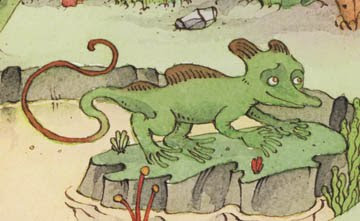Monday, January 18, 2010
Cheer up, rubber duckling!
Rubber duckling, take a look at this nice review of Hey, Rabbit! on School Library Journal.
As a rabbit pushes a large suitcase, many animals inquire about the contents. A toucan wonders, “HEY, Rabbit! Is there anything for me in your suitcase? Maybe a leaf to remind me of home?” Expectations are exceeded when each creature peeks inside. For example, Toucan discovers a tropical paradise full of exotic flora and fauna. More fantasies come true: a dog finds a birthday cake made of bones, a cat discovers a room full of yarn, and a hungry mouse enjoys tasting stacks of cheese. Ruzzier’s delicate ink-and-watercolor illustrations have a quirky, dreamy quality. After everyone’s wishes have come true, Rabbit wonders, “HEY, is there anything for me in my suitcase?” [...] Pair this with Katie Cleminson’s Magic Box (Hyperion, 2009) for a fanciful storytime. – Linda Ludke, London Public Library, Ontario, Canada
Monday, January 11, 2010
The tools
The drawings for Hey, Rabbit! where done in pen & ink and watercolors.
I use an old orange wooden pen which is quite thick, so it fits well in my hand.
The metal nib is very fine, but flexible enough to get different thicknesses, even within the same line.
(This is a detail of a drawing I'm working on now for a different book.)
For Hey, Rabbit! I used black and sepia ink. Sepia is a nice grayish tone of brown. I don't know if they still produce it the same way, but originally sepia ink came from the ink sacs of cuttlefish.
I paint with four or five red (or Kolinsky) sable hair brushes of different sizes, with a round, pointy tip.
My watercolors are mostly Schmincke. They're the best I've tried so far.
Since I started painting with watercolors, I've always used Arches paper, "grain torchon", or rough.
And this is my desk, in my studio in Clinton Hill, Brooklyn:
I use an old orange wooden pen which is quite thick, so it fits well in my hand.
The metal nib is very fine, but flexible enough to get different thicknesses, even within the same line.
(This is a detail of a drawing I'm working on now for a different book.)
For Hey, Rabbit! I used black and sepia ink. Sepia is a nice grayish tone of brown. I don't know if they still produce it the same way, but originally sepia ink came from the ink sacs of cuttlefish.
I paint with four or five red (or Kolinsky) sable hair brushes of different sizes, with a round, pointy tip.
My watercolors are mostly Schmincke. They're the best I've tried so far.
Since I started painting with watercolors, I've always used Arches paper, "grain torchon", or rough.
And this is my desk, in my studio in Clinton Hill, Brooklyn:
Tuesday, January 5, 2010
The basilisk
The basilisk exists both in real life and in legends.
The one that appears in the jungle spread of Hey, Rabbit! is more or less taken from the actual reptile.
(This one in the picture is from the Honolulu Zoo.)
According to Leonardo da Vinci, the basilisk likes to hide on the high tree branches and then stare at his (or her) victims as they wilt to death. That's not nice.

Other authors report similar behaviors, but if you look at my basilisk's face, would you believe she (or he) would be capable of such a thing?
The one that appears in the jungle spread of Hey, Rabbit! is more or less taken from the actual reptile.
(This one in the picture is from the Honolulu Zoo.)
According to Leonardo da Vinci, the basilisk likes to hide on the high tree branches and then stare at his (or her) victims as they wilt to death. That's not nice.

Other authors report similar behaviors, but if you look at my basilisk's face, would you believe she (or he) would be capable of such a thing?
Subscribe to:
Posts (Atom)














